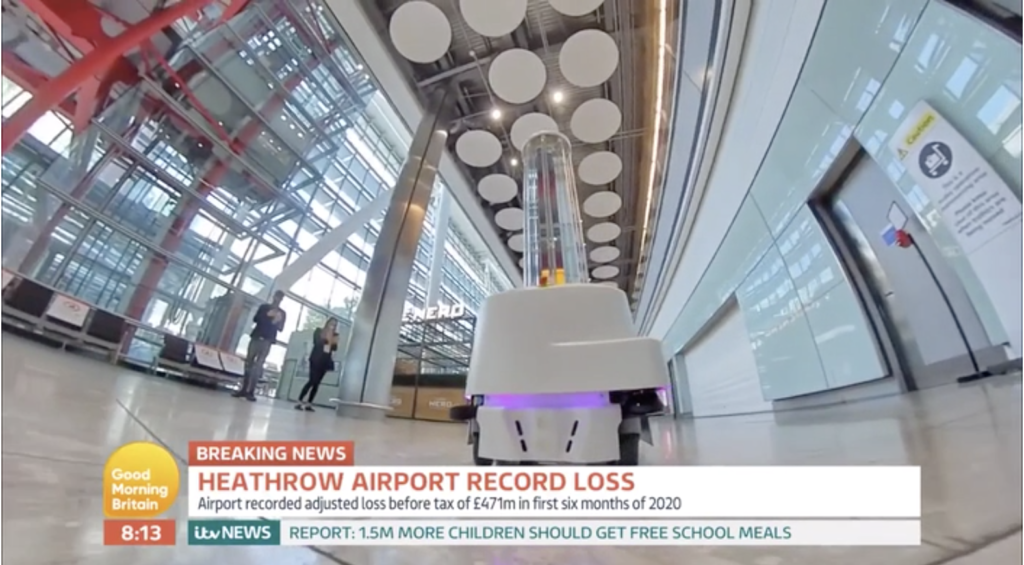After revenue dropped by a staggering 85% and passenger numbers plummeted by 96% in July this year, worries about the future of the aviation industry continue to grow. Travel restrictions, difficult social distancing abilities, and the high number of critical touch points within airports and on planes are making it increasingly difficult to safely open airports to full capacity. However, despite the Covid-19 pandemic and it’s disastrous impact, the importance of the aviation industry to the British economy remains unchanged and much needed solutions to these issues are being discovered.
Speaking on ITV’s Good Morning Britain about health and safety at Heathrow airport, Chief Executive John Holland-Kaye explained that the “aviation sector has been devastated by Covid” and that “we rely on aviation for tourists coming into the UK, staying in hotels, to see our sights and until we can get aviation flowing again […] then the UK economy is going to be sputtering along.” Holland-Kaye then explained how the aviation sector will not return to its former glory without keeping the nation safe and that Heathrow will take “no steps to risk re-infection.”
Watch NESA Robotics UVD Robots on ITV’s Good Morning Britain

Despite the state of the aviation sector, Holland-Kaye and Heathrow’s directors are optimistic in their discovery of new and industry-changing technology to help fight the presence of Covid-19 in airports. Heathrow now uses UVD Robots (UV Disinfection Robots) or ‘Covid-19 Killing Robots’ to disinfect each terminal of their ever-expanding airport. Supplied by NESA Robotics these UVD Robots have 360 degree disinfection coverage, 2.5 hour battery life and are wireless and wifi connected. Used primarily in their toilets, which have as Holland-Kaye explains been “mapped out and stored in their robot’s memory”, these ‘Covid-19 Killing Robots’ are able to make the most private and well-used spaces Covid-safe.
Pioneered in European hospitals and trusted throughout the health-care sector to kill hospital super-bugs, Holland-Kaye explained that the robot “cleans to emergency room health standards” and “uses ultraviolet light to deep clean surfaces that can’t easily be got to.” ITV News spoke to CEO of Nordic Eye, Heath Williams who explained that the robots use “UVC light, and that’s not able to get through the ozone layer, so the virus doesn’t have an immune system to UVC light, so the light breaks down its DNA and is able to kill the Coronavirus in just a matter of seconds.”
Within airports, there are multiple key touch points needing constant and thorough disinfection, and handrails, sinks, toilet doors, handles, lift buttons can be easily disinfected by UVD robots killing 99.9999.% of viruses, bacteria and other pathogens. Equally, ITV News’ Martin Stew explained how UVD Robots have a huge amount of power and are able to “sanitise up to 18,000 square metres of space one one two and a half hour battery cycle.” Williams also explained that the “bottom is an autonomous robot”, and after the owner maps out the chosen rooms with the paired tablet, it can function independently, reducing the need for any human management, saving time and money. Using exactly the same technology, UVC light has been extended to escalator handrails, where it has been placed under the rail to disinfect as it turns.
At Heathrow their utmost priority is the safety and security of everyone at the airport. Heathrow COO, Emma Gilthorpe explains that they’ve been using UVD Robots as well as other “technologies to make sure we keep our airport safe for our passengers and our colleagues, at the moment the most important thing is building confidence so that people get back flying.” Both Emma and John share that confidence in safe and Covid-free travel is what will restore the aviation sector to its former success, and Heathrow trusts UVD Robots to help restore this confidence.
Tested and regulated thoroughly, UVD technology is proving successful and John Holland-Kaye explained that people have “had a really good experience and felt looked after” that “they’ve relaxed as soon as they’ve got there” and “the measures tak[en] are helping to keep people safe and also make them feel safe and get them confident to get back flying again.”
Extending beyond the healthcare sector and into the workplace, UVD robots are becoming essential in the fight against Covid-19. By allowing people to safely travel and trust the travel sector once more, ‘Covid Killing Robots’ are restoring faith in a sector essential to the UK economy and important to millions of jobs.
Hoping to be used in hospitals and offices across London, the time and money-saving benefits of UVD Robots is being shared. Able to perform 2 days of disinfection in just 1 hour these robots are useful to a wide range of business and sectors and look set to also build people’s confidence in going back into the office.
You can see the technical specifications of the UVD Robots and see how they may be useful in a wide range of industries on the NESA Robotics product page.
